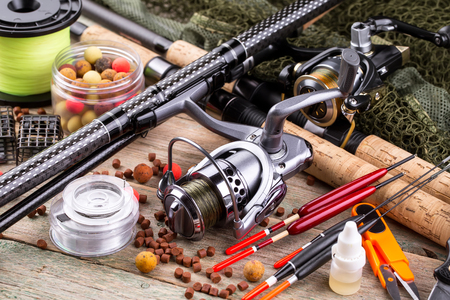Understanding the Basics of a Tackle Box
Every bass angler knows that having the right tackle box is just as important as picking the right fishing spot. Your tackle box is your mobile command center—keeping your gear organized, protected, and easy to access when you need it most. Whether youre hitting a local pond or heading out for a weekend on the lake, understanding what makes a great tackle box can set you up for bass fishing success.
What Is a Tackle Box and Why Do You Need One?
A tackle box is essentially your portable storage solution for all things fishing. It keeps your lures, hooks, weights, tools, and other gear sorted and ready for action. For bass fishing, where conditions can change fast and adaptability is key, having your essentials at your fingertips is crucial. A well-organized box means less time fumbling around and more time catching fish.
Types of Tackle Boxes Commonly Used in Bass Fishing
Not all tackle boxes are created equal. Here’s a quick rundown of the most popular options among American bass anglers:
| Type | Description | Best For |
|---|---|---|
| Hard Plastic Box | Classic tray-style boxes with multiple compartments; durable and stackable. | Bank fishing, boat trips |
| Tackle Bag (Soft Sided) | Nylon or polyester bags with removable plastic trays; lightweight and easy to carry. | Bass tournaments, shore fishing |
| Pocket Organizer | Small boxes or pouches for quick trips or specific lure types. | Kayak fishing, short sessions |
| Backpack Tackle System | Backpack with built-in tackle storage; hands-free carrying. | Hiking to remote spots, wading rivers |
Tips to Keep Your Gear Organized and Ready for Action
- Group by Category: Separate lures by type (crankbaits, soft plastics, jigs), keep hooks and weights in their own sections.
- Label Compartments: Use a label maker or write directly on dividers so you can find what you need fast—even with wet hands.
- Keep Tools Accessible: Stash pliers, scissors, and line cutters in exterior pockets or top trays for quick access.
- Toss Trash Bags In: Carry small zip bags for used soft plastics or packaging so you leave no trace behind.
- Check Before You Go: Give your tackle box a once-over before every trip to restock essentials like hooks, leader material, and terminal tackle.
- Add Moisture Absorbers: Throw in a few silica gel packs to prevent rust on metal gear.
The Bottom Line: Be Prepared for Anything
The right tackle box not only keeps you organized but also lets you adapt fast when bass get finicky. Choose the type that fits your style of fishing and keep it stocked and sorted—you’ll spend less time searching and more time landing big ones.
2. Must-Have Lures and Baits for Bass
Every American bass angler knows that having the right lures and baits can make or break a day on the water. Whether you’re fishing your local lake, river, or pond, these essentials should always be in your tackle box. Here’s a quick rundown of what you need, when to use them, and why they work.
Top Lures Every Bass Angler Should Carry
| Lure/Bait | Best For | Why It Works | When to Use |
|---|---|---|---|
| Plastic Worms | Largemouth & Smallmouth Bass | Versatile, realistic movement; effective year-round | All seasons, especially spring and summer |
| Crankbaits | Catching active bass in open water | Mimics baitfish; covers water quickly | Spring through fall, clear or stained water |
| Spinnerbaits | Muddy or stained water, windy days | Flash and vibration attract bass even in low visibility | Spring and fall, overcast or windy conditions |
| Jigs (with trailers) | Ledges, docks, heavy cover | Imitates crawfish or baitfish; great for big bass | Year-round, especially winter and pre-spawn |
| Topwater Lures (Frogs, Poppers) | Shallow water, heavy vegetation | Create surface commotion; explosive strikes from bass | Early morning or late evening, warm months |
| Soft Plastic Swimbaits | Casting near structure or weed lines | Lifelike action; great for pressured fish | Anytime bass are chasing baitfish, all year round |
| Lipless Crankbaits (Rattle Traps) | Covers lots of water quickly, deeper areas | Noisy rattle triggers reaction bites; sinks fast to desired depth | Fall and early spring; when bass are schooling up |
| Ned Rigs/Z-Man TRDs (Midwest Finesse) | Tough bite conditions, clear lakes/ponds | Sneaky presentation; works when nothing else does | Post-front days, high pressure systems |
Local Favorites Worth Packing
- Crawfish-imitating jigs: Hot in southern states like Texas and Alabama where crawfish are natural forage.
- Paddle-tail swimbaits: Go-to choice on the West Coast and Great Lakes region for imitating shad and perch.
- Buzzbaits: A Midwest favorite for explosive topwater action during summer mornings.
Tackle Box Tip:
If you’re fishing unfamiliar waters, ask locals about what’s working lately. Regional preferences can change with seasons and weather patterns. Keeping a good mix of classic lures plus a few local favorites will cover just about any scenario you encounter on the water.
Bass Fishing Quick Guide:
- If the water is clear: Go natural—use green pumpkin worms or shad-colored crankbaits.
- If it’s muddy: Bright colors (chartreuse) or lures with lots of vibration like spinnerbaits stand out.
- If bass are active on the surface: Toss a frog or popper near lily pads or weed mats.
This well-rounded lure selection helps you adapt to changing conditions and ensures you’re ready for whatever the day brings on the lake.
![]()
3. Hooks, Weights, and Terminal Tackle
When it comes to bass fishing, having the right hooks, weights, and terminal tackle in your box is a game-changer. These are the tools that connect you to the fish, and using the right ones for different situations makes all the difference. Let’s break down what you need and when to use them.
Hook Sizes and Types
Bass fishing hooks come in various shapes and sizes, each suited for specific baits and presentations. Here’s a quick guide:
| Hook Size | Best For | Common Use |
|---|---|---|
| 1/0 – 2/0 | Small soft plastics | Finesse rigs, drop shot |
| 3/0 – 4/0 | Medium plastics (worms, craws) | Texas rig, Carolina rig |
| 5/0+ | Large plastics, swimbaits | Punching thick cover, big worms |
Extra Tip: Always keep a mix of offset worm hooks, EWG (extra wide gap) hooks, and straight shank hooks for different lure types.
Weights: When and What to Use
The right weight helps get your bait to where the bass are hiding. Here’s a rundown on common bass fishing weights:
| Weight Type | Use Case | Main Advantage |
|---|---|---|
| Bullet Weight | Texas rigging soft plastics | Slices through weeds; versatile for cover fishing |
| Drop Shot Weight | Suspend bait above bottom structure | Keeps bait off the bottom; ideal for finesse setups |
| Sinker (Egg/Slip) | Carolina rigs, live bait setups | Adds casting distance; slides on line for natural bait movement |
| Nail Weight/Wacky Rig Weight | Neko rigs or wacky rigs with stickbaits | Adds subtle action; good for pressured fish or clear water |
Terminal Tackle Must-Haves
Your terminal tackle ties everything together. Don’t leave home without these essentials:
- Swivels: Prevent line twist when using spinning baits or rigs like Carolina.
- Snap Swivels: Quick lure changes; handy if you’re trying different presentations.
- Peg Stops: Hold bullet weights in place—crucial when flipping heavy cover.
- Beads: Add sound and protect knots on Carolina rigs.
- Sinker Stops: Keep slip sinkers from sliding too far; essential for precise presentations.
- Split Rings & Replacement Treble Hooks: Upgrade crankbaits or topwater lures as needed.
- Bait Keeper Clips: Secure soft plastics so they last longer.
Tackle Box Checklist: Hooks, Weights & Terminal Gear at a Glance
| Tackle Item | # to Pack (Min.) |
|---|---|
| Diverse Hook Sizes/Styles (1/0–5/0) | 10-20 assorted per trip |
| Bass Weights (Bullet, Drop Shot, Sinkers) | 8-12 mixed sizes/types |
| Peg Stops & Beads | A handful of each |
| Swivels & Snap Swivels | 6-10 assorted |
A Few Pro Tips:
- If you fish heavy cover or around rocks often, pack extra hooks—you’ll lose some along the way!
- Lighter weights work best in calm water or when fish are spooky; heavier weights punch through grass or current.
No matter where you’re headed—lakes, rivers, or farm ponds—having this range of hooks, weights, and terminal tackle means you’re ready for whatever the bass throw at you!
4. Line Selection and Management
Choosing the right fishing line can make or break your bass fishing trip—literally. With so many options on the market, it’s easy to get overwhelmed. Here’s a rundown of the most popular fishing lines in the U.S., how to pick the best one for bass, and some real-world tips for keeping your line trouble-free.
Popular Fishing Lines in America
| Type | Strengths | Weaknesses | Best Use for Bass |
|---|---|---|---|
| Monofilament (Mono) | Affordable, flexible, easy to tie knots | More stretch, less sensitivity, weaker abrasion resistance | Topwater lures, beginners, general use |
| Braided Line | High strength, no stretch, great sensitivity | Visible in clear water, tough to cut or tie knots | Heavy cover, thick weeds, flipping and pitching |
| Fluorocarbon (Fluoro) | Almost invisible underwater, strong abrasion resistance | Stiffer, can be pricey, may coil on reels | Clear water, finesse presentations, crankbaits |
How to Choose the Right Line for Bass Fishing
- Water Clarity: Go with fluorocarbon if you’re fishing clear lakes—its near invisibility gives you an edge.
- Casting Distance: Braided line is your best friend if you need long casts or are targeting bass in heavy vegetation.
- Lure Type: Mono works well for topwater baits since its natural stretch keeps fish from throwing hooks during jumps.
- Knot Strength: Fluorocarbon and mono both hold knots well; braided line may need special knots like a Palomar or Double Uni.
- Toughness: If you’re beating around rocks or logs, braided or fluoro lines are tougher than mono.
Tackle Box Tip: Keep Multiple Lines Handy
A lot of American anglers carry a couple of spools—one braid and one fluoro—to swap out as conditions change. Don’t be afraid to mix things up until you find what works at your lake.
Troubleshooting: Preventing Snarls and Breakage
- Avoid Overfilling Your Reel: Leave a 1/8-inch gap at the rim to keep line from tangling.
- Straighten Out Line Memory: Run new line through your fingers before tying on a lure; this helps take out coils.
- Lubricate Knots: Wet your line before cinching down knots—this reduces friction and breakage.
- Check for Nicks: After every few casts (especially around cover), run your fingers down a couple feet of line to check for rough spots. Retie if needed.
- Tangle Prevention: Use a line conditioner spray or swap out old line regularly for smooth casting.
Bass Angler’s Hack: Store Extra Spools in Zip Bags
If you want to stay organized and avoid moisture damage, store spare spools in zip-top bags right in your tackle box. That way you’ll always have fresh line ready when you need it most.
5. Tools and Accessories That Save the Day
Every bass angler knows that having the right lures and baits is just half the battle—its the small tools and accessories in your tackle box that truly keep your day on the water running smooth. Whether youre fixing a snag, cutting line, or handling a big catch, these essentials make all the difference. Here’s what you need to have on hand for a safe, hassle-free fishing experience.
Pliers: Your Go-To Multi-Tool
A solid pair of pliers is non-negotiable. They help you unhook fish quickly (and safely), pinch split shot, bend hooks back into shape, or even pull out stubborn treble hooks. Needle-nose pliers are especially popular among American bass anglers for their reach and precision.
Line Cutters: Quick and Clean
Scissors work, but dedicated line cutters or snips are faster and safer for slicing through mono, fluoro, or even tough braided line. Some anglers prefer small side cutters or nail clippers—just make sure whatever you use has a sharp edge.
Stringers & Fish Grips: Secure Your Catch
If you’re planning to keep your catch, stringers help you safely hold fish in the water. For catch-and-release folks, fish grips offer a secure way to handle bass without injuring them—or yourself.
Must-Have Tools & Accessories at a Glance
| Item | Purpose | Why It Matters |
|---|---|---|
| Pliers | Unhooking fish, bending hooks | Keeps hands safe; quick hook removal |
| Line Cutters/Snips | Cutting fishing line | Clean cuts; prevents tangles and wasted time |
| Stringer | Holding live fish in water | Keeps your catch fresh until youre ready to leave |
| Fish Grips/Lip Gripper | Handling bass safely | Protects both angler and fish during release |
| Tape Measure/Ruler | Measuring your catch | Stay legal with size limits; bragging rights! |
| First Aid Kit (Mini) | Treat minor cuts/scrapes | Avoid infections from hooks or fins |
| Tackle Retriever/Plug Knocker | Freeing stuck lures/hooks | Saves money on lost gear; reduces frustration |
| Sunscreen & Bug Spray (Travel Size) | Protection from sun and insects | Makes long days on the lake more comfortable |
Packing Tips: Keep It Simple & Accessible
You don’t need to pack your entire garage—just focus on these core tools. Store them in an easy-to-reach spot in your tackle box or vest so you aren’t fumbling when you need them most. Trust us: a little preparation goes a long way toward making every trip a good one.
6. Safety, Regulations, and Local Tips
Basic Safety Gear for Bass Fishing
Staying safe on the water is just as important as having the right lure. Here’s a quick checklist of essential safety items every American angler should have in their tackle box or boat:
| Safety Gear | Purpose |
|---|---|
| Personal Flotation Device (PFD) | Keeps you afloat if you fall in |
| First Aid Kit | Handles minor injuries and emergencies |
| Sunscreen & Bug Spray | Protects against sunburn and insects |
| Polarized Sunglasses | Shields your eyes from glare and UV rays |
| Waterproof Flashlight or Headlamp | Essential for low-light conditions or night fishing |
| Multi-tool or Pocket Knife | For cutting line, fixing gear, or emergencies |
| Whistle or Air Horn | To signal for help if needed |
| Bottle of Drinking Water & Snacks | Stay hydrated and energized all day long |
Understanding Local Fishing Laws and Regulations
No matter where you cast your line in the U.S., following state and local fishing laws is a must. Each state has different rules about what you can catch, how many fish you can keep, and what gear is allowed. Avoid fines and keep fisheries healthy by checking these before you head out:
- Licensing: Most states require a valid fishing license. Buy online through your state’s fish and wildlife website or at local outdoor stores.
- Catch Limits: Know the daily bag limits for bass and any size restrictions.
- Bait & Tackle Rules: Some lakes don’t allow live bait or certain types of hooks. Check signs at launch sites or look up regulations online.
- Seasons: Certain times of year may be closed to bass fishing to protect spawning fish.
- No-Trespassing: Respect private property—only fish where it’s legal.
Quick Reference: Where to Find Local Regulations Online
| Region/State | Main Website for Regulations |
|---|---|
| California | wildlife.ca.gov/Fishing/Inland |
| Texas | tpwd.texas.gov/regulations/outdoor-annual/fishing/ |
| Florida | myfwc.com/fishing/freshwater/regulations/ |
| Minnesota | dnr.state.mn.us/regulations/fishing/index.html |
| Nationwide Info (Federal Waters) | fws.gov/fishing |
Tried-and-True Advice from Experienced American Anglers
- Tell Someone Your Plans: Always let a friend or family member know where you’re fishing, especially if heading to remote spots.
- Check the Weather: Sudden storms are no joke. Use weather apps before launching your boat or hiking into new areas.
- Pace Yourself: It’s easy to lose track of time when the bite is on—drink plenty of water and take breaks in the shade.
- Tidy Up: Pack out all trash, old line, and hooks. A clean lake means better fishing for everyone.
- Treat Wildlife with Respect: Watch out for snakes near shorelines, and don’t disturb nesting birds or other animals.
Your Tackle Box Isn’t Complete Without Safety First!
A well-stocked tackle box goes beyond lures and hooks—it includes everything you need to stay safe, legal, and ready for action on the water. By following basic safety steps, knowing the laws, and listening to seasoned anglers’ advice, you’ll get more out of every American bass fishing trip.


